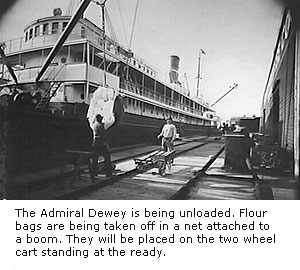The Mechanization and
Modernization Agreement

In January 1961, an agreement between the International Longshoremen's &
Warehousemen's Union (ILWU) and the Pacific Maritime Association (PMA)
changed the nature of work on the waterfront from Bellingham, Washington
to San Diego in Southern California.
The
agreement allowed ship owners and stevedoring contractors to be "freed
of restrictions on the introduction of labor-saving devices, relieved of
the use of unnecessary men and assured of the elimination of work
practices which impede the free flow of cargo or ship turnaround. The
guarantees to industry are in exchange for a series of benefits for the
workers to protect them against the impact of the machines on their
daily work or on their job security."
 Long before the Agreement, mechanization in handling cargo began to make
longshore work easier: rope slings attached to booms on the ship lifted
heavy loads both on and off the ship, taking sacks, boxes and barrels
off the longshoreman's back. Four wheel dollies and eventually forklifts
moved cargo around on the dock and in the ship's hold. Once in the ship,
cargo was stowed by hand to take advantage of all the nooks and
crannies. A tight stow maximized the use of space, prevented cargo from
shifting during the voyage, and
Long before the Agreement, mechanization in handling cargo began to make
longshore work easier: rope slings attached to booms on the ship lifted
heavy loads both on and off the ship, taking sacks, boxes and barrels
off the longshoreman's back. Four wheel dollies and eventually forklifts
moved cargo around on the dock and in the ship's hold. Once in the ship,
cargo was stowed by hand to take advantage of all the nooks and
crannies. A tight stow maximized the use of space, prevented cargo from
shifting during the voyage, and
was the pride of the skilled longshoreman.
 By the 1940s, new forms of mechanization began to significantly reduce
the number of men required to do a particular task. For example, when
raw sugar was
shipped in bags, stowed by hand and discharged sack by
sack, it required seven 10-hour shifts for five gangs of longshoremen to
unload the vessel--a total of 6,650 man hours. In 1942, sugar began to
be shipped in bulk, moving on and off the ship in huge bins on conveyor
belts. It took only 1,000 man hours to unload the ship. And in the
warehouse, 600 men were needed to handle sacks of sugar; only 200 were
needed to tend to the bulk sugar.
By the 1940s, new forms of mechanization began to significantly reduce
the number of men required to do a particular task. For example, when
raw sugar was
shipped in bags, stowed by hand and discharged sack by
sack, it required seven 10-hour shifts for five gangs of longshoremen to
unload the vessel--a total of 6,650 man hours. In 1942, sugar began to
be shipped in bulk, moving on and off the ship in huge bins on conveyor
belts. It took only 1,000 man hours to unload the ship. And in the
warehouse, 600 men were needed to handle sacks of sugar; only 200 were
needed to tend to the bulk sugar.
The Mechanization and Modernization Agreement paved the way for new
forms of mechanization, like containerization of cargo which dropped the
need for longshore work on a ship from 11,088 hours to about 850 hours.
Writers of the Agreement realized that their approach to the inevitable
loss of jobs to machines was revolutionary. While they took care of the
longshoremen then working, they didn't have all the answers for the
future. Those answers, addressing jobs and the economy of our city, are
up to us, their children.
From Otto Hagel and Louis Goldblatt, Men and Machines
 "Walk Along the Water"
"Walk Along the Water"
© Oakland Museum of California, used with permission.

 back
back